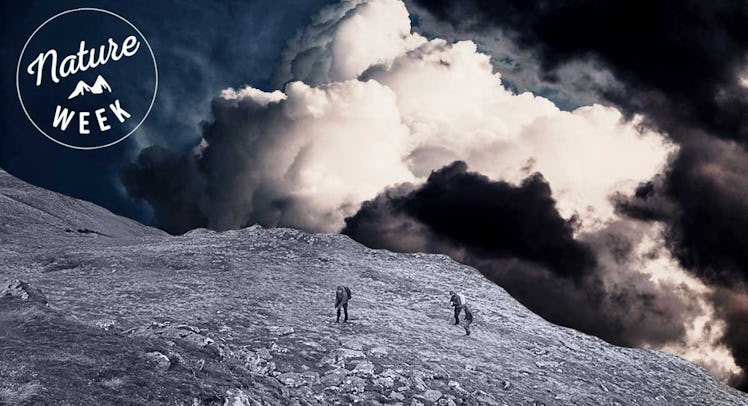The Brutal, Important Lesson Only Nature Can Teach Kids
Which is exactly why kids need it.

The Skyline Trail runs for five miles atop Kittatinny Ridge in Hawk Mountain Sanctuary in Kempton, Pennsylvania, an hour and a half drive northwest from my childhood home. According to the official trail map, the Skyline Trail is a rugged and difficult climb, meant only for experienced hikers. There are four-point rock scrambles and a 30-foot drop just off the narrow trail. None of that deterred my mother from regularly rousing my sister and me early on weekend mornings — when I was nine and my sister was eleven — to hike it. Though I know now she was spurred by the migratory patterns of the kestrels, eagles, and osprey, at the time it just seemed like random cruelty.
For kids, hikes are always epic. Strides are smaller, mountains bigger, and brambles exceedingly eye-level. But the hyperbole of pre-pubescence notwithstanding, my mother’s hikes were actually nasty, brutish, and incredibly long. It didn’t matter if it was raining or frigid or if the narrow blue-blazed path was slick with fallen leaves, my mother marched us around the Skyline Trail loop, driving us relentlessly along the longest possible route to get to the place we started. It didn’t matter how much I pleaded or how dramatically I flounced upon a boulder, declaring myself too exhausted to continue, the trail was the trail, the incline was the incline, and the only way forward was forward.
I don’t look back at Skyline Trail with overwhelming fondness, but I do appreciate the lesson I learned there: Reality is non-negotiable. Kids, especially privileged ones, sometimes struggle to learn this. Sometimes they don’t learn it at all (and go into politics). My mom made me face this fact by showing me, repeatedly and weirdly early in the day, that nature doesn’t care.
As adults, we tend to see the world as either for us or against us. We curse the rain when it spoils our picnics and bless it when it nourishes our crops. We hurl abuse at the heat when our air conditioners are on the fritz and our balls stick unpleasantly to our inner thighs and praise it when it allows us to forego our shirts, exposing our man boobs to the world. For and against; for and against; for and against. As children, this interpretative tendency is even more distilled. The smaller the body, the higher molarity of opinion. Have you ever seen a toddler be equanimous?
I remember one hike in particular. It took place a little past that half-way point on my journey of acceptance. The sky opened up on us as we reached the Northern Lookout (Elevation 1521) and looked out on the Delaware Water Gap. Everything we had was soaked: the peanut butter-and-jelly sandwiches on whole wheat, the Ziploc baggies of trail mix, my book of Mad Libs, and us. Soaked to the bone and suddenly cold, I communicated my misery with the fervor only a child can muster. Nothing happened. I didn’t get less wet. I couldn’t even manage to hold a grudge against the cloud. My discomfort was simply what it was. The only solution was to get off the ridge.
After I got that, I began to love being outdoors. It was a relief to be around trees, rocks, and winds that had no agenda — that wanted nothing from me and offered nothing but their beauty. Nature felt true; sometimes uncomfortably so, but nonetheless.
Reflecting on it now, it seems strange for young me, a boy struggling with feelings of abandonment in the wake of his parents’ divorce, to be attracted to indifference. But the apathy of the natural world felt like safety or, perhaps more pointedly, stability. The woods never changed its mind.
Over the years, I pushed farther and farther into the wilderness, to the outer boundaries of what I could handle, drawn not just by the brilliance of the open sky or the crunch of snow underfoot, but by the high-stakes libertarianism of the outdoors. Rain or shine, live or die, it didn’t matter. The ravines and gullies would still be there. The waves would still crash. The desert sand still swept into dunes. The trees would still fall, even if I wasn’t there to hear them. But if I wanted to survive, it was on me to learn the skills to do it. Whatever challenges that came my way were impersonal, deadly but impersonal.
Those days of weeks-long solo journeys on the Appalachian Trail or butting up against danger surfing waves beyond my ken are gone. Yet the lessons are still there, perhaps even more now than ever. Older now, with higher stakes and more of a mixed record, I return to that moment on Hawk Mountain often. Failure comes but it isn’t personal. Providence smiles but it isn’t personal. The world isn’t for me or against me. It just is.
With two boys of my own, I find myself reenacting my mother’s hikes. She had Hawk Mountain; We have Bear Mountain. She had the Skyline Trail; We have the Popolopen Torne Loop. Like me when I was near their age, my boys love the hike until they hate it. Like my mother when I was their age, I drive them onwards and upwards. The rain is still the rain, the snow is still the snow, and the sun is still the sun. It’s the same sky I looked towards as the boy and that covered me, beautiful and uncaring.